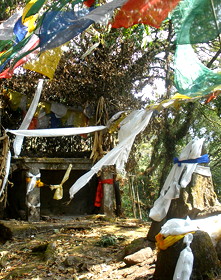
Kabi Longtsok
The appellation Kabi Longtsok derived from the sacred occasion of swearing-in of the oath of blood brotherhood between the great Lepcha patriarch Thekong Tek and Cho Khye Bhumsa in the 13th Century.
'Kabi' meaning Ka-yu-sa-bi or our blood and 'Long' meaning stone and 'Tsok' meaning erect in Lepcha. Kayu-sa-bi-na Long-tsok in Lepcha, that is, erect stone with our blood which is an oath sworn.
The modern history of Sikkim has direct connection with the history of the blood brotherhood between Thekong Tek and Khye Bhumsa.
Khye Bhumsa and his wife had no issue even after the passage of several years. When he heard about a legendary Lepcha patriarch Thekong Tek of Sikkim, who was duly venerated as an emanation of the Guru Rinpoche, he instantly decided to seek his blessing and according to the prophecy, set southward of Tibet. On meeting Thekong Tek, he requested him for the boon of a son. Thekong Tek considered the request and gave his blessings. The following year, a son was born to Khye Bhumsa. Much delighted by the miracle, Khye Bhumsa out of gratitude decided to pay tribute to the great Lepcha patriarch with gifts and offerings and visited him again at Kabi Longtsok.
During this meeting, Thekong Tek lifted the child in a playful mood. Accidentally, one foot of the child touched his forehead. Thekong Tek pondered over this occurrence and insisted on an oath of eternal blood brotherhood between Lepchas and the Bhutias.
This oath taking ceremony witnessed the sacrifice of several animals with invocation of the local deities to witness the occasion of this solemn oath of blood brotherhood between the Lepchas and Bhutias as one and inseparable single entity. Both, Thekong Tek and Khye Bhumsa, put their feet in a blood-filled vessel and sat upon raw animal hides with the intestines of the animals tied around them and blood splattered all around. Thekong Tek invited and involved all the local deities led by the eternal guardian deity of Sikkim Khang-Chen-dzod-nga or Kintsoom Zaongboo Cheu to witness the historic occasion of the blood brotherhood treaty.
He also directed the deities to bless those who observed this oath most sincerely and faithfully and curse those who try to break their relationship or refuse to comply with it.
As such, realizing the prophecies of Guru Rinpoche and as discharged and interpreted by the great Lepcha patriarch Thekong Tek, the indigenous Bhutia-Lepchas became a single inseparable entity since the 13th century A.D. after this historic oath taking ceremony, which was witnessed by none other than the Khangchen Dzod-nga Tag-Tse at Kabi Longtsok Drag-Chen.
Commemorating the significance of the event, the supreme guardian deity of Sikkim, Mount Khangchen Dzonga, is still venerated also as Witness God during the annual Pang-Lhabsol ceremony in Sikkim.
After this, the descendants of Khye Bhumsa - Mipon-Rab, Guru Tashi, Gyalpo Apha, Gyalpo Nagpo, Guru Tenzing and then the first consecrated Chogyal of Sikkim, Phintso Namgyal in 1642 A.D. - succeeded Khye Bhumsa.
To perpetuate the treaty and its objective of unity, peace and harmony amongst the future generation of the land, a symbolic stone was erected as per tradition with blood splattered over it, which can be witnessed even today where we pray, worship and make offerings without or with our Bongthings and Monks traditionally.
The value and significance of the 13th century blood brotherhood of Kabi Longtsok between Bhutia and Lepchas as single inseparable entity is legalized, approved and confirmed today by the parliament of the largest democratic country in the world officially as BL (Bhutia-Lepcha) and therefore, any attack to dislodge the brotherhood is unconstitutional, illegal and not acceptable as prophesied by the great patriarch Thekong Tek.
Resource: Save Kabi Longtsok Committee, An Appeal for Saving Kabi-Longtsok, Kabi, 2013

'Upright Stones'

Sanctuary at Kabi Longtsok